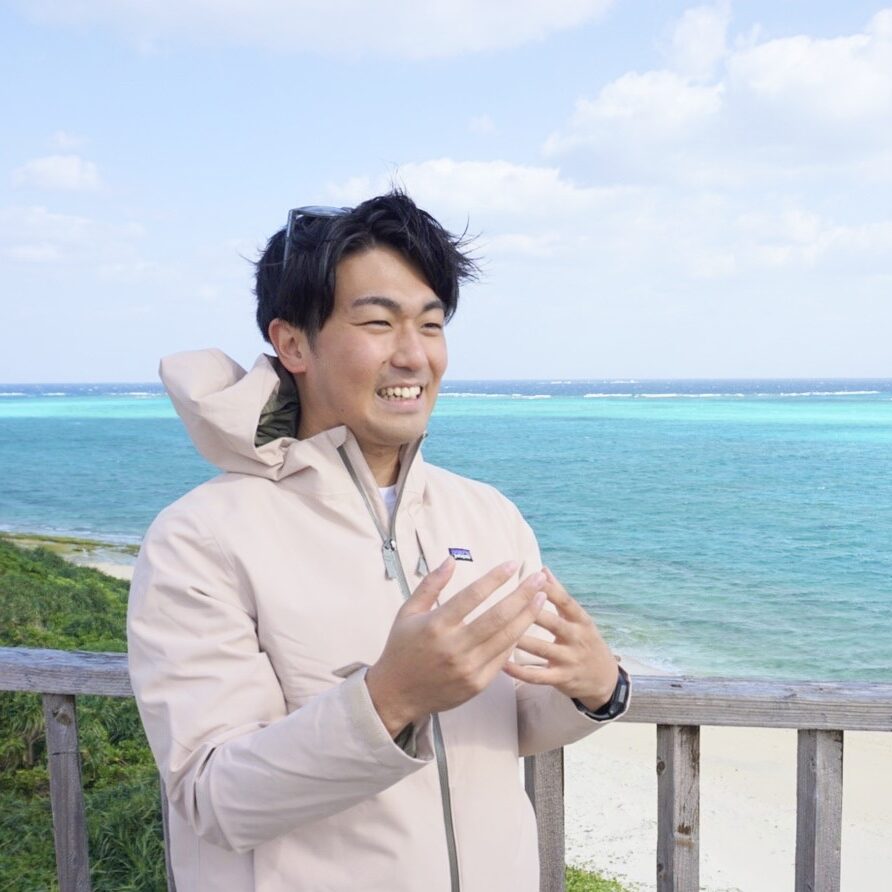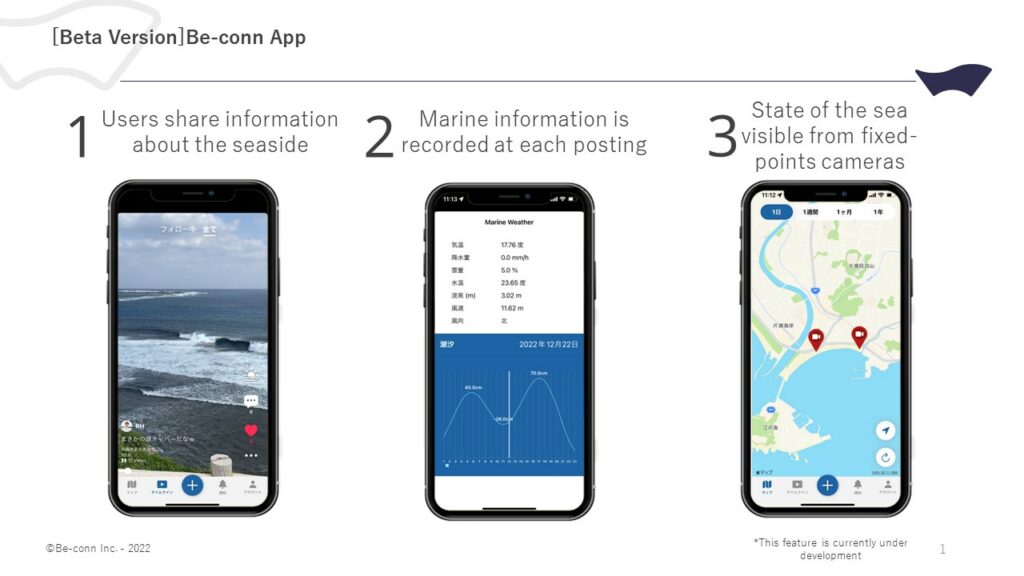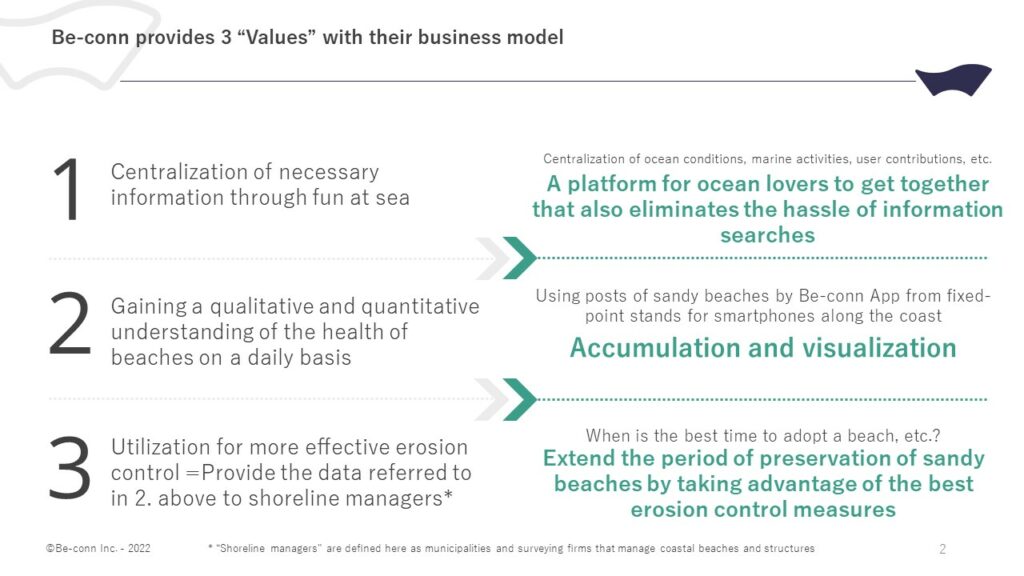Mr. Ryo Hirota, the CEO of Be-conn Inc.
Despite predictions that 90% of Japan’s sandy beaches could disappear by 2100, national and local governments tend to fall behind due to the lack of data on the current state of sandy beaches. Be-conn Inc. has released an app called Be-conn to protect the richness of the sea by allowing users to shoot and post images and videos of the seaside with their smartphones. The following is an interview with Mr. Ryo Hirota, the CEO of the company.
―Coastal erosion caused by rising sea levels is a global problem that has been gaining attention. How can people protect the richness of the sea by taking pictures of sandy beaches with their smartphones?

Our idea is to set up smartphone stands at fixed sites along the shore. We ask local residents and nearby business owners to shoot the sea using our app, Be-conn. The accumulated data will enable us to quantify the state of sandy beaches to know their health.
In order to prevent the loss of sandy beaches and coastal disasters, it’s vital to first correctly understand the state of the coastlines. In Australia, there is an app called CoastSnap*, which inspired us to create a Japanese version.
―Are the sandy beaches in such a bad state?
It is predicted that climate change could eliminate about half of the world’s sandy beaches by 2100. At a recent coastal symposium organized by the National Association of Sea Coast, one of the participants said that it wouldn’t be a surprise if 90% of Japan’s sandy beaches disappeared by then.
―What would happen if sandy beaches disappeared?
If they disappear, coastal disasters may occur. Along Route 134 in Kamakura, a road collapsed in 2019 right in front of restaurants and hotels. Restoration work was finally completed in 2022.
Once something like this happens, it takes a lot of time and money to get it back.
―So it’s a big blow to residents and businesses in the area.
There are many small businesses such as restaurants and activity providers along the coast, and it’s a big loss for the railway companies along the line. They don’t have enough supporting data to persuasively ask local governments to take direct measures. In other words, people and businesses in the area continue to have vague anxieties about coastal erosion disasters.
―Be-conn can contribute to solving the problem, though, right?
The problem is that frequent monitoring to understand the vulnerability of sandy beaches hasn’t been conducted in the first place. Goal 14 of the SDGs is “Life Below Water: Conserve and sustainably use the world’s oceans, seas, and marine resources.” We hope to provide services to support the initiatives of sea-related companies.
―You founded Be-conn Inc. and released the beta version of Be-conn in April 2022, but I heard that you used be Japan’s national lifesaving player. What made you get involved with the sea?
When I was child, I had childhood asthma and moved from Tokyo to the coast of Fujisawa City, Kanagawa Prefecture, on the wishes of my mother, who heard that the sea breeze was good for the disease. A book about dolphins I found in a bookstore inspired me to work to swim with the dolphins, so I started swimming. When I was a college student, I started lifeguarding using my swimming skills. I have always felt the sea close to me.
―What kind of work did you do before you started Be-conn Inc.?
My previous job was selling advertorials on a general information website called All About. However, I quit the job in one year because I had a strong desire to use all my time to get involved with the sea. I had also always wanted to resolve issues between the sea and people.
After that, I studied business administration for two years at the Sawada Institute of Management, sponsored by Hideo Sawada, the founder of H.I.S. Co., Ltd. I collaborated with the Matsushita Institute of Government and Management and developed new businesses at a subsidiary of H.I.S., and then I started Be-conn Inc.
―Could you tell us about the business model for the app Be-conn?
One of the features of this app is that it provides UI/UX for users to have fun by using it as social media. For example, when a user posts a photo of a coastline, it is reflected as marine weather information. Users can also see other people’s posts, including videos. Therefore, we are considering charging businesses a monthly or annual fee for directing nearby users to their websites within the app.
―I see. In other words, you’ll be charging businesses near the coastline, not users.
We also hope to eventually centralize sea-related information, including underwater activities, lodging, and food with this app. Since I myself am in the target demographic of this business, I know well that it takes a lot of time and is very cumbersome to research such information.
In addition to preserving the coast, we’d like to support people and companies doing business in the coastal area to help them increase sales.
―Does that mean that you aim to provide information media focused entirely on the sea?
If there is such an app, I assume people who love the sea will definitely use it, and if the number of visits increases, we’d like to monetize our app with advertising fees. We’re also considering adding reservation functions like other reservation websites. We hope to create a situation where people say that when it comes to the sea, Be-conn is the best among various reservation sites.
―How do you use coastline photos and videos shot from smartphone stands at fixed locations?
We provide them free of charge to the national and local governments because we’d like them to use the information to resolve coastal erosion problems as well as to prevent and mitigate disasters. In turn, we ask them to help us set up shooting stands at fixed locations.
―User cooperation is essential to collect data. Do you offer any kind of incentive to motivate users to submit posts?
Like CoastSnap, which we used as a model, we actually don’t offer any obvious incentive. However, people who usually take a walk on the beach or go to the sea often have a strong desire to do something for the sea, and their voluntary cooperation by shooting plays a very important part.
―It’s surprising. I wonder if that’s the way it is.
People often say to us, “Who would ever submit their posts?” But in reality, there are quite many users who do so. For me, it seems similar to asking Twitter users why they tweet.
However, relying solely on users’ voluntary cooperation is still not enough, so we are thinking of partnering with a telecommunications carrier to give some rewards in the form of points. We are also considering incorporating gamification by adding features that motivate users to submit a series of posts.
―I see. What kinds of feedback have you received since the release of the app?
We have started to receive positive evaluations from various organizations. Currently, our main focus is on the sea of Shonan, but we hope to expand it to the sea around Japan and eventually the entire world in the future. We have also been selected for Sido Next Innovator 2022, a program of the Ministry of Economy, Trade and Industry.
―Could you tell us about any future plans you may have?
Shooting data contains a lot of micro information. We’d like to improve our accuracy by matching that data with monitoring images from satellites.
Our ambition is to expand our scope to include not only disaster prevention and mitigation on the coastline, but also the preservation of biodiversity, covering the maintenance of coral reefs, marine debris, and features and vegetation on sandy beaches.
―It would be great if you can expand your business to that extent by utilizing users’ photo data.
To ensure the reliability of our product, users are currently not allowed to submit posts from their photo folders, but we are going to improve that function because there have been many requests from users about it. In addition to the current ability to post videos in real time that have not been processed, we are considering providing a function that allows users to post past videos and images from their photo folders and creating an environment where they can watch fixed-point cameras along the coast.
* An app that collects information about coastlines in the world. It converts photos of beaches taken by users at the same site into coastal data that is used by coastal scientists to predict how coastlines will change in the future.
| Company name:Be-conn Inc. |
| Founded:April 7, 2022 |
| Main business:Planning, developing, and operating a smartphone app and web services URL:https://be-conn.com |
This article is part of a series of articles introducing venture companies working together as ICF members to resolve societal issues.







